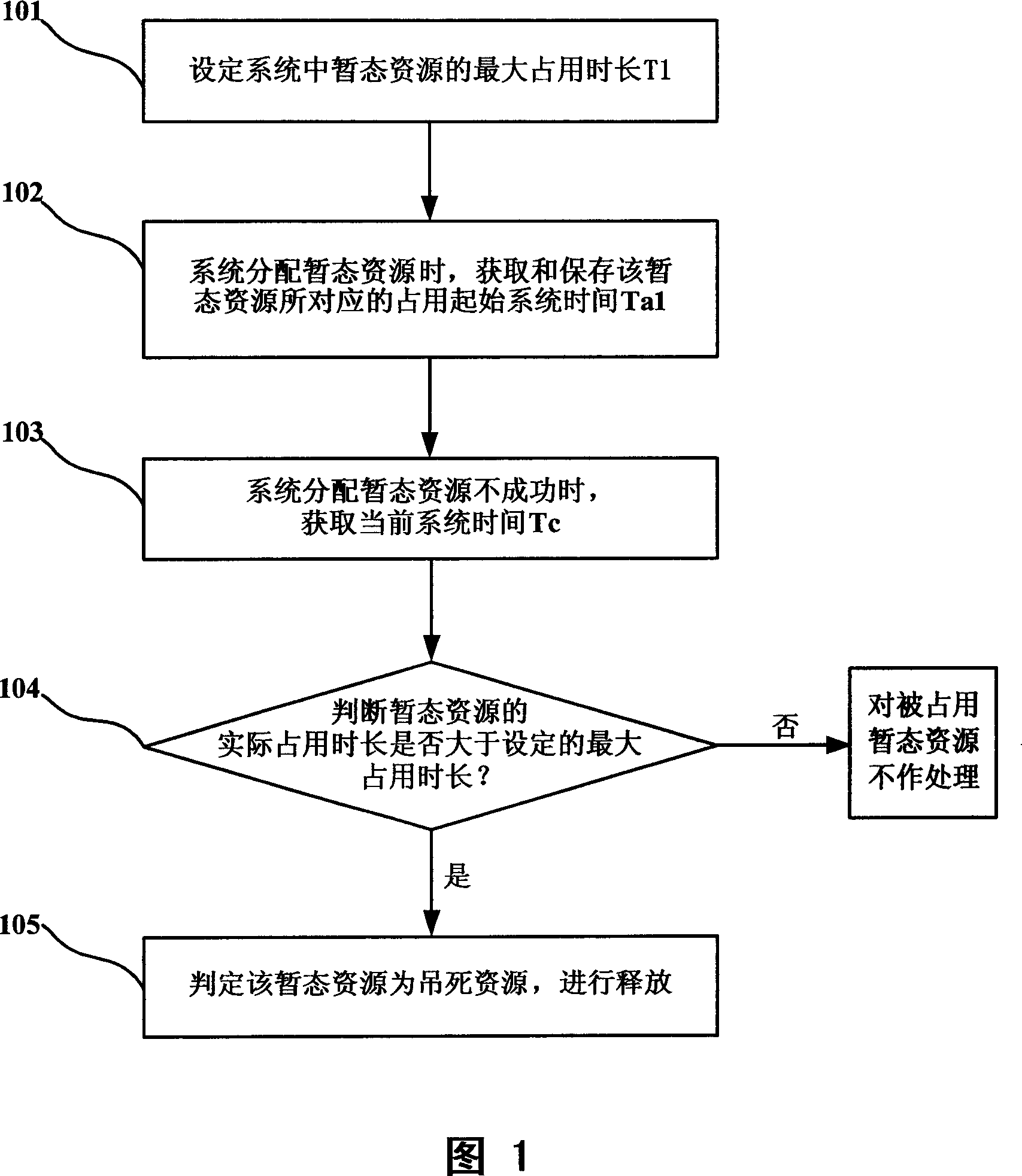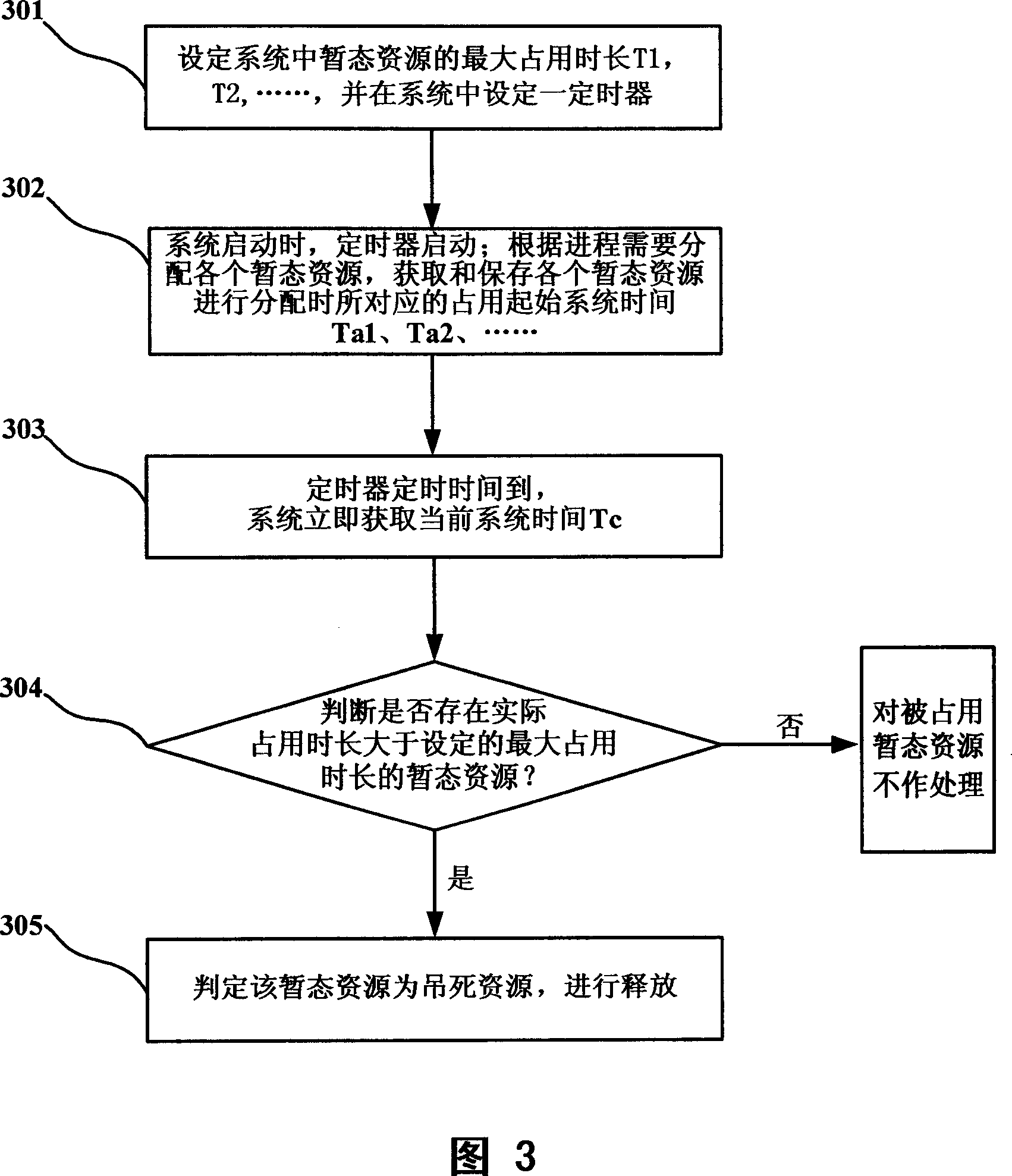Release method for death resource
A resource and timer technology, applied in the field of hanging resource release, can solve problems such as unavailable system functions, insufficient transient resources in the system, network communication interruption, etc., to improve stability and robustness, and prevent communication system resources from exhaustion effect
- Summary
- Abstract
- Description
- Claims
- Application Information
AI Technical Summary
Problems solved by technology
Method used
Image
Examples
Embodiment 1
[0040] As shown in FIG. 1 , the method for releasing hanging resources in Embodiment 1 of the present invention includes the following steps:
[0041] Step 101, according to the system design requirements, after analyzing the operation of each process in the system, set the maximum occupation time of the only transient resource in the system as T1;
[0042] Step 102, the system allocates transient resources according to the needs of the process, and obtains and saves the occupied initial system time Ta1 corresponding to the allocation of the transient resources;
[0043] Step 103, during system operation, when a new process needs to allocate transient resources, and there are no idle transient resources in the system, the allocation of transient resources is unsuccessful, and the system immediately obtains the current system time Tc;
[0044] Step 104, calculate the time difference between the current system time Tc and the occupied initial system time Ta1, obtain the actual o...
Embodiment 2
[0048] As shown in FIG. 2 , the method for releasing hanging resources in Embodiment 2 of the present invention includes the following steps:
[0049] Step 201, the system sets the maximum occupancy duration of each transient resource in the system as T1, T2, ... according to the configuration status of its software and hardware, and sets a resource hanging inspection cycle in the system;
[0050] Step 202, the system allocates each transient resource according to the needs of the process, and acquires and saves the occupied initial system time Ta1, Ta2, ... corresponding to each transient resource for allocation;
[0051] Step 203, during the system operation, according to the setting of the inspection cycle of the suspended resources, when a new round of inspection starts, the system obtains the current system time Tc;
[0052]Step 204, respectively calculate the actual occupation time corresponding to each transient resource that is still in use, that is: the current system...
Embodiment 3
[0056] As shown in FIG. 3 , the method for releasing hanging resources in Embodiment 3 of the present invention includes the following steps:
[0057] Step 301, according to the protocol requirements used by the system, set the maximum occupation time of each transient resource in the system as T1, T2, ..., and set a cycle timer in the system, here cycle The timer refers to: the timer timing information automatically triggers the next work of the timer to start;
[0058] Step 302, when the system is started, start the timer at the same time; the system allocates each transient resource according to the process needs, acquires and saves the occupied initial system time Ta1, Ta2, ... corresponding to the allocation of each transient resource;
[0059] Step 303, during system operation, when the timer expires, the system immediately acquires the current system time Tc;
[0060] Step 304, respectively calculate the actual occupation time corresponding to each transient resource t...
PUM
 Login to View More
Login to View More Abstract
Description
Claims
Application Information
 Login to View More
Login to View More - R&D
- Intellectual Property
- Life Sciences
- Materials
- Tech Scout
- Unparalleled Data Quality
- Higher Quality Content
- 60% Fewer Hallucinations
Browse by: Latest US Patents, China's latest patents, Technical Efficacy Thesaurus, Application Domain, Technology Topic, Popular Technical Reports.
© 2025 PatSnap. All rights reserved.Legal|Privacy policy|Modern Slavery Act Transparency Statement|Sitemap|About US| Contact US: help@patsnap.com



